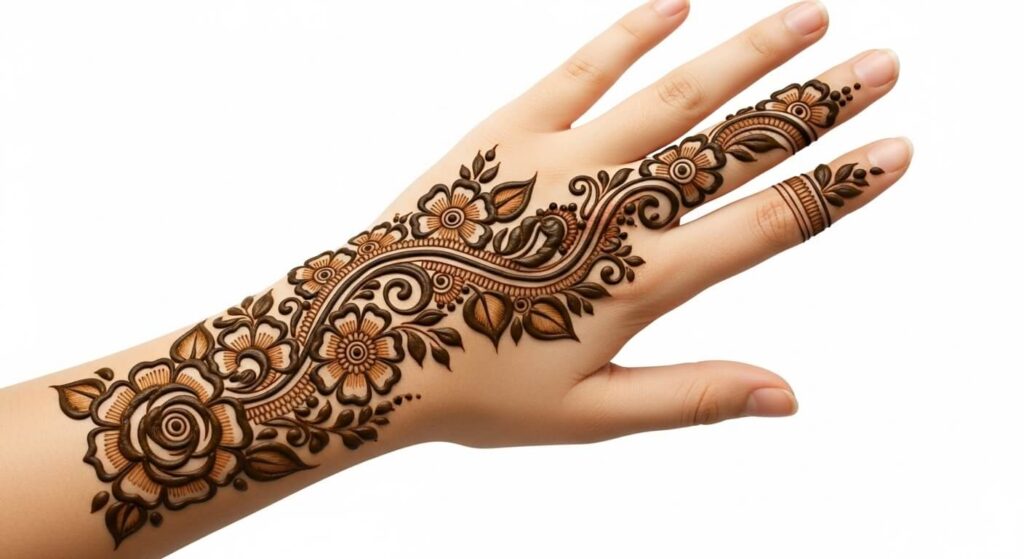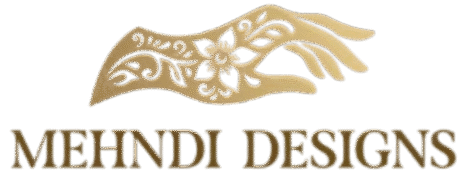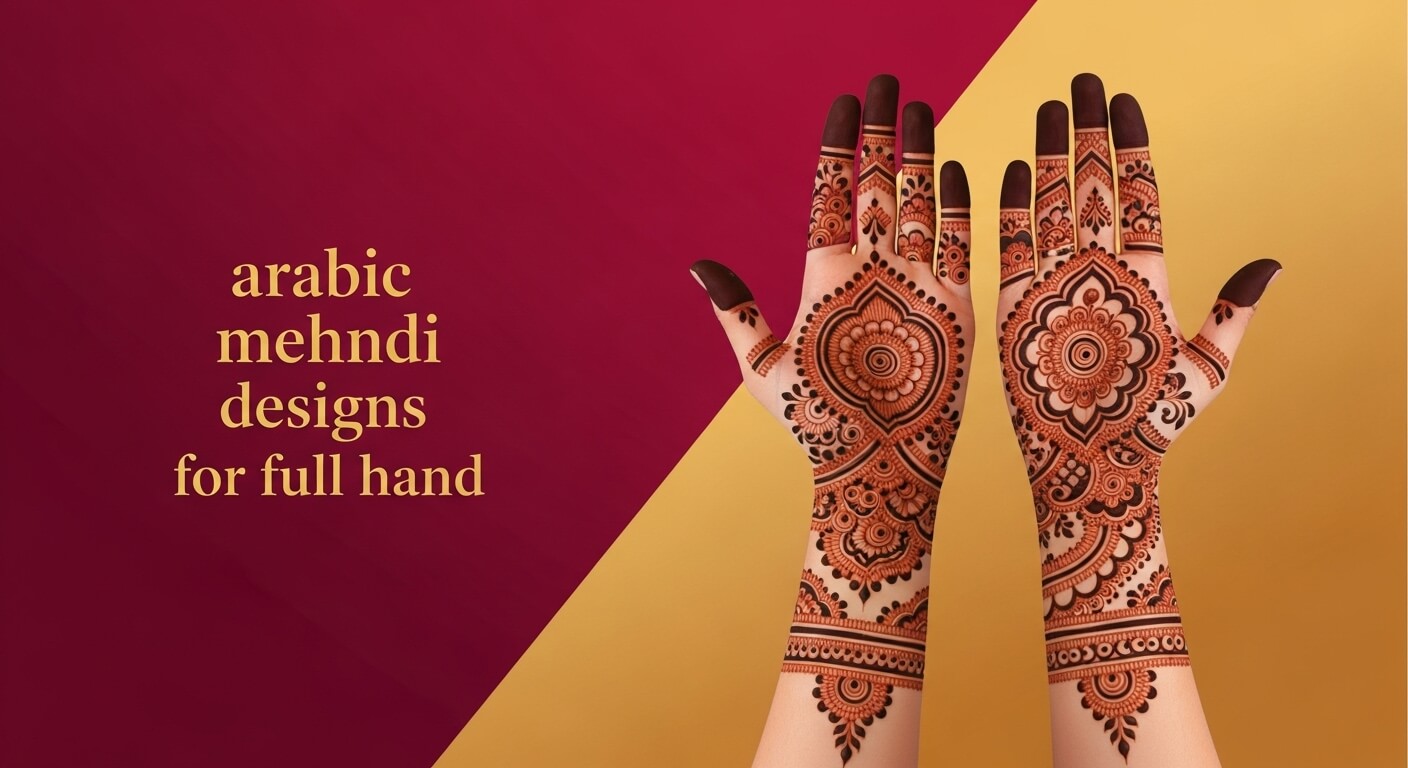Arabic mehndi designs have long been admired for their elegance, bold strokes, and flowing patterns. Whether you’re preparing for a wedding, Eid, Diwali, or any celebration, full-hand Arabic mehndi remains a timeless choice. Brides love its richness, while professionals admire the balance of artistry and efficiency.
In this article, we will explore 17 popular Arabic mehndi design styles for full hands, along with tips, trends, and FAQs. Each design is broken down into detailed insights so you can choose the perfect style for your next event.
Why Choose Arabic Mehndi Designs?
Arabic mehndi stands out because of its clean patterns and artistic flow. Unlike Indian mehndi, which can be dense and detailed, Arabic styles emphasize bold outlines and negative space. This makes them quicker to apply yet still stunning.
For brides, Arabic mehndi is both traditional and versatile. For professionals, it offers endless creativity with motifs like florals, paisleys, vines, and peacocks. Whether minimalist or intricate, there’s a design that suits every personality and occasion.
17 Popular Arabic Mehndi Design Styles for Full Hands
Floral Vine Arabic Mehndi

Floral vines are among the most graceful Arabic mehndi patterns, flowing from fingertips to wrists. The curved flowers and leaves create natural elegance. This design suits both weddings and festivals. Brides love floral vines for their versatility and timeless beauty. They can be kept light for subtle looks or made dense for full bridal coverage. The adaptability makes them a favorite worldwide.
For mehndi artists, floral vines are efficient and easy to customize. They can be drawn quickly yet still look detailed. This balance of speed and style makes them highly in demand.
Paisley Arabic Mehndi
Paisleys are a classic motif, symbolizing tradition and richness in design. Their droplet-like shapes flow seamlessly across palms. This makes them perfect for full-hand decoration. They pair beautifully with vines, nets, and florals to create harmony. Layered paisleys enhance depth and add elegance. Brides often choose them for a regal touch.
Professionals rely on paisleys as a foundation for Arabic mehndi. They’re versatile, timeless, and easy to combine with other motifs. This ensures endless creativity.
Geometric Arabic Mehndi
Geometric designs stand out for their boldness and symmetry. Patterns like triangles, squares, and diamonds create structure. They give Arabic mehndi a modern edge. Brides who want contemporary elegance often prefer geometric motifs. The neatness and balance enhance the full-hand look. This style is fashionable yet rooted in tradition.
For professionals, geometric mehndi demands precision. Steady strokes and consistent spacing are essential. Mastering it elevates artistic skill and creativity.
Net Pattern Arabic Mehndi
Net or mesh-like designs mimic delicate lace. They fill empty spaces without overwhelming the hand. The result is a subtle yet striking pattern. Brides favor net patterns as fillers in dense mehndi. They complement florals, paisleys, and peacocks beautifully. This creates a rich but balanced effect.
Artists use nets to add texture and elegance. They are versatile and work for both light and heavy styles. This makes them a reliable choice in any design.
Peacock Arabic Mehndi
Peacock motifs add grandeur with their flowing feathers. The detailed strokes bring life and movement to the design. They symbolize beauty and elegance. Brides often choose peacocks as a centerpiece in full-hand mehndi. The feathers extend gracefully across the palm. This adds a luxurious touch.
For professionals, peacock designs showcase skill. They require patience and detailing but impress clients greatly. They’re a signature of bridal artistry.
Mandala Arabic Mehndi
Mandala designs start with a circular motif at the palm. Expanding outward, they create symmetry and depth. The simplicity is visually captivating. They symbolize unity, balance, and wholeness. Brides prefer them for their spiritual and aesthetic value. Combined with vines, they transform into rich designs.
Artists enjoy mandalas for their adaptability. They can be minimal for casual wear or detailed for weddings. Their balance makes them universally loved.
Bracelet Arabic Mehndi
Bracelet designs focus on wrist patterns like cuffs or bangles. They look like natural jewelry drawn with henna. The motifs extend into fingers gracefully. Women prefer bracelet styles for casual events. They’re light, stylish, and wearable daily. It’s a chic option for professionals as well.
For mehndi artists, this style is quick and elegant. It takes less time but still impresses clients. Its jewelry-like appeal is always in trend.
Minimalist Arabic Mehndi
Minimalist designs use fewer motifs with open space. They are subtle yet elegant. The simplicity highlights Arabic artistry beautifully. Modern brides and professionals love minimalist mehndi. It’s comfortable, fashionable, and quick to apply. Perfect for light occasions.
Artists find this style practical. It saves time without compromising beauty. Minimalist designs are especially popular in 2025.
Bold Stroke Arabic Mehndi
Bold stroke designs use thick lines to emphasize motifs. The contrast makes patterns pop. They are striking even from a distance. Brides choose bold strokes for visibility in photos. The defined outlines enhance paisleys, florals, and peacocks. This adds drama to the look.
For professionals, bold strokes are efficient. They require fewer fillers but still impress. Perfect for big events where impact matters.
Leafy Arabic Mehndi
Leaf motifs flow like climbing vines across the hand. Their natural curves add freshness. Combined with florals, they create harmony. Brides favor leafy trails for subtle elegance. They balance heavier motifs like paisleys and peacocks. This makes hands look graceful.
For artists, leafy patterns are simple yet beautiful. They’re easy to draw and versatile. Their timeless charm ensures demand.
Intricate Arabic Mehndi
Intricate mehndi fills every inch with detail. It combines florals, nets, and swirls. The dense style looks luxurious. Brides love intricate designs for their richness. They’re perfect for weddings and grand occasions. The artistry symbolizes tradition.
For professionals, this style requires patience. It’s a premium service due to the time involved. The results are worth the effort.
Modern Fusion Arabic Mehndi
Fusion designs mix Arabic with Indian or Moroccan styles. Bold outlines pair with detailed fillers. The result is unique and creative. Brides seeking individuality prefer fusion mehndi. It reflects cultural blends with a modern twist. It’s stylish and eye-catching.
For artists, fusion is a playground of ideas. They can experiment with spacing and motifs. No two designs look alike.
Front and Back Full-Hand Arabic Mehndi
This design decorates both sides of the hands. Symmetry ensures balance and beauty. It’s ideal for brides. The front often features heavy motifs like mandalas. The back may include vines or bracelet styles. Together, they create harmony.
Professionals enjoy creating full-hand symmetry. It requires planning and skill. The results are stunning for weddings.
Glitter Arabic Mehndi
Glitter accents highlight motifs with sparkle. They add a festive, glamorous touch. Perfect for parties and celebrations. Brides use glitter mehndi for receptions or sangeet. The shine enhances traditional designs. It pairs well with colorful outfits.
For artists, glitter allows creativity. They can experiment with shades and highlights. It makes designs eye-catching and fun.
Finger-Tip Arabic Mehndi
This style emphasizes finger detailing. The palms remain lighter for contrast. It creates a chic effect. Brides who want subtlety prefer finger-tip designs. They highlight elegance without heaviness. The style is trendy and modern.
For professionals, this design is quick. It’s fashionable among younger clients. Easy yet impactful.
Bridal Arabic Mehndi
Bridal Arabic mehndi is dense and elaborate. It covers palms, fingers, and wrists fully. It symbolizes beauty and tradition. This design includes paisleys, florals, and peacocks. It often extends to the forearms. Brides choose it for weddings.
Professionals consider bridal mehndi a specialty. It demands skill, time, and precision. It’s one of the most valued services.
Negative Space Arabic Mehndi
Negative space designs leave intentional gaps. This contrast highlights bold motifs. The result looks clean and modern. Brides prefer negative space for contemporary elegance. It blends minimalism with tradition. The trend is growing fast in 2025.
For professionals, this design is efficient. It balances effort and impact. A perfect choice for stylish clients.
Tips for Perfect Arabic Mehndi Application
- Use fresh, natural henna for a darker and longer-lasting stain.
- Apply a lemon-sugar mixture once the paste dries to lock in color.
- Keep hands warm and avoid water for at least 6–8 hours after application.
- Start with large motifs and fill spaces with smaller details for balance.
- Add fusion elements like glitter or geometric lines for a trendy twist.
Trending Arabic Mehndi Styles in 2025
- Negative space Arabic mehndi is gaining popularity for its chic, modern vibe.
- Minimalist designs are loved by working professionals who want subtle elegance.
- Fusion patterns that combine Indian, Moroccan, and Arabic motifs are trending for weddings.
- Glitter-enhanced mehndi is making waves in festive and party looks.
FAQs About Arabic Mehndi Designs
Which Arabic mehndi design is best for brides?
Dense Arabic mehndi designs with florals, paisleys, and peacocks are most popular among brides, as they cover both palms and wrists beautifully while symbolizing elegance and tradition.
How long does Arabic mehndi last?
With proper care like avoiding water, applying lemon-sugar, and keeping hands warm, Arabic mehndi can last between 7–14 days, gradually fading to a lighter brown.
What’s trending in Arabic mehndi in 2025?
The top trends include negative space patterns, glitter accents, and minimalist full-hand designs, as they combine modern style with Arabic tradition.
Can Arabic mehndi be mixed with other styles?
Yes, many mehndi artists combine Arabic patterns with Indian or Moroccan motifs, creating fusion designs that feel unique, stylish, and perfect for weddings or festivals.
Are Arabic mehndi designs simple or complex?
They can range from minimal floral vines and leafy trails to dense bridal patterns with peacocks and mandalas, making them suitable for both casual wear and grand events.
Conclusion
In conclusion, From delicate floral vines to bold negative space patterns, Arabic mehndi designs for full hands offer endless creativity. Brides love their richness, professionals value their efficiency, and fashion enthusiasts admire their timeless appeal.
Whether you’re preparing for a wedding, festival, or party, these 17 popular styles ensure your hands stand out with beauty and elegance. Explore, experiment, and embrace the art of Arabic mehndi in 2025.

